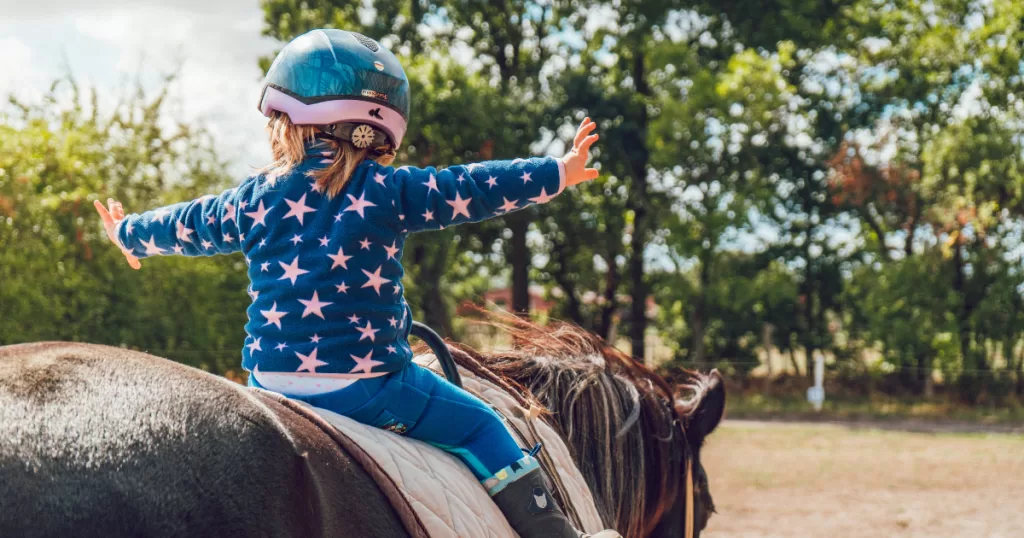
A strong, balanced seat is fundamental for effective and harmonious riding. It provides stability and allows for better communication with your horse, resulting in a smoother ride and a more responsive partnership. Developing a strong seat takes time, patience, and practice, but the benefits are well worth the effort. Here’s how you can build a more secure and balanced seat:
Ready to Become a Confident Rider?
Sign up to our Free Newsletter for exclusive tips, tricks and tidbits that will help you grow as a beginner equestrian.
1. Understand the Basics of a Good Seat
Before you can develop a strong seat, it’s essential to understand what a good seat involves. A strong seat is one that is:
- Balanced: Your weight is evenly distributed in the saddle, and you are aligned with your horse’s movement.
- Relaxed: You should be able to absorb the horse’s motion without becoming rigid or tense.
- Responsive: A strong seat allows you to give subtle cues to your horse through your body position and movements.
2. Work on Core Strength
A strong core is crucial for maintaining balance and stability in the saddle. Incorporate exercises that target your core muscles, such as:
- Planks: Hold a plank position for 30 seconds to 1 minute. This exercise strengthens your abdominal muscles and improves overall stability.
- Leg Raises: Lying on your back, lift your legs to a 90-degree angle and lower them slowly. This helps build lower abdominal strength.
- Russian Twists: Sit on the floor with your knees bent and feet lifted. Hold a weight or medicine ball and twist your torso from side to side.
3. Practice Correct Positioning
Proper positioning in the saddle is crucial for developing a strong seat. Here’s what to focus on:
- Alignment: Sit upright with your shoulders back, chest open, and your pelvis aligned with the horse’s movement.
- Deep Seat: Sit deep in the saddle, allowing your seat bones to make contact with it. Avoid perching on the saddle or leaning too far forward.
- Leg Position: Your legs should hang naturally, with your heels slightly lower than your toes. Avoid gripping with your knees or thighs.
4. Focus on Flexibility
Flexibility in your hips and legs can improve your seat by allowing for more fluid movement. Incorporate stretching exercises into your routine:
- Hip Flexor Stretch: Kneel on one knee with the other foot in front, and gently push your hips forward to stretch the front of your hip.
- Hamstring Stretch: Sit on the floor with one leg extended and the other bent. Reach towards the extended leg to stretch your hamstring.
- Quadriceps Stretch: Stand on one leg, grab your opposite ankle behind you, and gently pull it towards your glutes to stretch the front of your thigh.
5. Ride Without Stirrups
Riding without stirrups is an excellent way to develop a more secure seat. It forces you to use your core and leg muscles to maintain balance. Start with short periods and gradually increase the duration as you become more comfortable.
6. Practice at the Walk
The walk is a great gait to practice and develop your seat. Focus on maintaining a deep, balanced seat as you ride. Pay attention to how your seat bones make contact with the saddle and how your body moves with the horse.
7. Use Ground Exercises
Ground exercises can help you develop a better sense of balance and body awareness. Practice exercises such as:
- Balance Ball Work: Sit on a balance ball and practice maintaining your balance while moving your arms or legs. This simulates the movement of the horse and helps improve your stability.
- Body Alignment Exercises: Stand against a wall with your heels, hips, and shoulders touching. This helps you become aware of your body alignment and improves your posture.
8. Seek Professional Guidance
A riding instructor can provide valuable feedback on your seat and offer personalized exercises to help you improve. Regular lessons can help you make adjustments and track your progress over time.
Conclusion
Developing a strong seat is a journey that involves working on your core strength, flexibility, positioning, and balance. By incorporating these practices into your routine, you’ll build a more secure and balanced seat, enhancing your overall riding experience and strengthening your partnership with your horse. Happy riding!
Ready to Become a Confident Rider?
Sign up to our Free Newsletter for exclusive tips, tricks and tidbits that will help you grow as a beginner equestrian.
